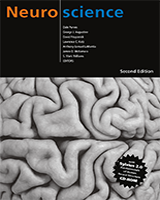By agreement with the publisher, this book is accessible by the search feature, but cannot be browsed.
NCBI Bookshelf. A service of the National Library of Medicine, National Institutes of Health.
Purves D, Augustine GJ, Fitzpatrick D, et al., editors. Neuroscience. 2nd edition. Sunderland (MA): Sinauer Associates; 2001.

Neuroscience. 2nd edition.
Show detailsIn humans, olfaction is often considered the least acute of the senses, and a number of animals are obviously superior to humans in their olfactory abilities. This difference is probably explained by the larger number of olfactory receptor neurons (and odorant receptor molecules; see below) in the olfactory epithelium in many species and the relatively larger area of cortex devoted to olfaction. In a 70-kg human, the surface area of the olfactory epithelium is approximately 10 cm2. In contrast, a 3-kg cat has about 20 cm2 of olfactory epithelium. Humans are nonetheless quite good at detecting and identifying airborne molecules in the environment (Figure 15.2). For instance, the major aromatic constituent of bell pepper (2-isobutyl-3-methoxypyrazine) can be detected at a concentration of 0.01 nM. The threshold concentrations for odorant detection and identification nonetheless vary greatly. Ethanol, for example, cannot be identified until its concentration reaches approximately 2 mM. Small changes in molecular structure can also lead to large perceptual differences: The molecule d-carvone smells like caraway seeds, whereas l-carvone smells like spearmint!

Figure 15.2
Chemical structure and human perceptual threshold for 12 common odorants. Molecules perceived at low concentrations are more lipid-soluble, whereas those with higher thresholds are more water-soluble. (After Pelosi, 1994.)
Since the number of odorants is very large, there have been several attempts to classify them in groups. One useful classification was developed in the 1950s by John Amoore, who divided odors into categories based on their perceived quality, molecular structure, and the fact that some people, called anosmics, have difficulty smelling one or another group. The categories Amoore described were pungent, floral, musky, earthy, ethereal, camphor, peppermint, ether, and putrid, and these are still used to describe odors, to study the cellular mechanisms of olfactory transduction, and to discuss the central representation of olfactory information. Nevertheless, this classification remains entirely empirical. A further complication in rationalizing the perception of odors is that their quality may change with concentration. For example, at low concentrations indole has a floral odor, whereas at higher concentrations it smells putrid. Despite these problems, the longevity of Amoore's scheme makes clear that the olfactory system can identify odorant classes that have distinct perceptual qualities. Humans can, of course, perceive individual odorant molecules. Thus, coconuts, violets, cucumbers, and bell peppers all have a unique odor generated by a particular molecule. Most naturally occurring odors, however, are blends of several odorant molecules, even though they are typically experienced as a single smell (such as the perceptions elicited by perfumes or the bouquet of a wine).
Psychologists and neurologists have developed a variety of tests that measure the ability to detect common odors. Although most people are able to consistently identify a broad range of test odorants, others fail to identify one or more common smells (Figure 15.3). Such chemosensory deficits, called anosmias, are often restricted to a single odorant, suggesting that a specific element in the olfactory system, mostly likely an olfactory receptor type, is missing. For example, about 1 person in 1000 is insensitive to butyl mercaptan, the foul-smelling odorant released by skunks. More serious is the inability to detect hydrogen cyanide (1 in 10 people), which can be lethal, or ethyl mercaptan, the chemical added to natural gas to aid in its detection from leaks.

Figure 15.3
Anosmia is the inability to identify common odors. When subjects are presented with seven common odors (a test frequently used by neurologists), the vast majority of “normal” individuals can identify all seven odors correctly (in this (more...)
The ability to identify odors normally decreases with age. If otherwise healthy subjects are challenged to identify a large battery of common odorants, people between 20 and 40 years of age can typically identify about 50–75% of the odors, whereas those between 50 and 70 correctly identify only about 30–45% (Figure 15.4). A more radically diminished or distorted sense of smell can accompany eating disorders, psychotic disorders, diabetes, taking certain medications, and Alzheimer's disease (all for reasons that remain obscure). Although the loss of human olfactory sensitivity is not usually a source of great concern, it can diminish the enjoyment of food and, if severe, can affect the ability to identify and respond appropriately to potentially dangerous odors such as spoiled food, smoke, or natural gas (see above).

Figure 15.4
Normal decline in olfactory sensitivity with age. The ability to identify 80 common odorants declines markedly between 20 and 70 years of age. (After Murphy, 1986.)
- Olfactory Perception in Humans - NeuroscienceOlfactory Perception in Humans - Neuroscience
- ppdpf.L pancreatic progenitor cell differentiation and proliferation factor L ho...ppdpf.L pancreatic progenitor cell differentiation and proliferation factor L homeolog [Xenopus laevis]Gene ID:779234Gene
- rc3h1.L ring finger and CCCH-type domains 1 L homeolog [Xenopus laevis]rc3h1.L ring finger and CCCH-type domains 1 L homeolog [Xenopus laevis]Gene ID:414495Gene
Your browsing activity is empty.
Activity recording is turned off.
See more...